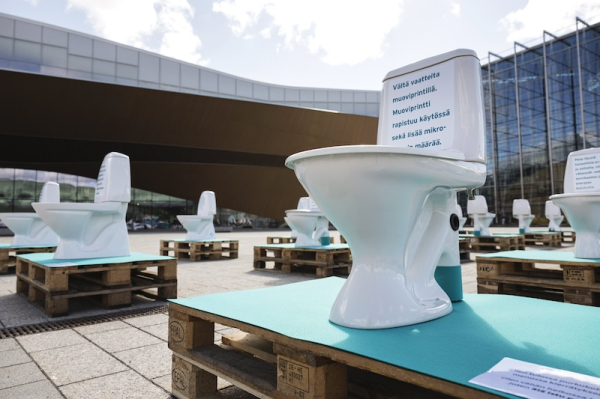
Helsinki Region Environmental Services, HSY, installed the toilet-based art piece The Baltic Sea’s Gates in Helsinki’s Kansalaistori Square on 7 May 2025. The artwork illustrates how harmful substances from everyday life can travel from homes to the Baltic Sea through toilets or drains. Photo: Roni Rekomaa / Lehtikuva
- Previous Article Drowning deaths in Finland double amid unsafe ice conditions
- Next Article Dispute over Chinese workforce at Kotka battery plant construction
Dozens of toilet seats arranged outside Helsinki’s Oodi library are drawing attention not to sanitation, but to sea pollution.
The installation, commissioned by Helsinki Region Environmental Services (HSY), is part of a public campaign to raise awareness of how everyday habits contribute to contamination of the Baltic Sea.
The work, titled Itämeren portit or The Baltic Sea’s Gates, features rows of toilet seats bearing messages about what people commonly flush — and where those substances end up.
Elina Tanner, environmental expert at HSY, said the aim is to make the public think more carefully about what they dispose of in toilets.
“Wastewater collects substances from clothing, detergents, cosmetics and medicines. Even though water is treated, not everything is filtered out,” Tanner said.
Despite modern wastewater treatment processes, many harmful chemicals and objects pass through filtration systems and eventually enter the sea. Among them is diclofenac, an anti-inflammatory drug commonly used in pain-relief gels, which Tanner said is particularly damaging to marine life.
Another component of the campaign is a display case inside Oodi library showing objects that have ended up in Helsinki’s sewage system. These include children’s toys and various non-biodegradable items often flushed away.
The campaign’s name in Finnish, Pytyllä on asiaa, loosely translates as “the toilet has something to say”, a phrase that plays on the expression “nature is calling.”
Tanner said public indifference or lack of awareness continues to pose a challenge. “People may not realise that what they flush affects ecosystems far beyond their home,” she said.
The art installation will remain on display throughout the month, encouraging reflection on individual choices and their wider environmental consequences.
HT
- Previous Article Drowning deaths in Finland double amid unsafe ice conditions
- Next Article Dispute over Chinese workforce at Kotka battery plant construction
Source: www.helsinkitimes.fi
